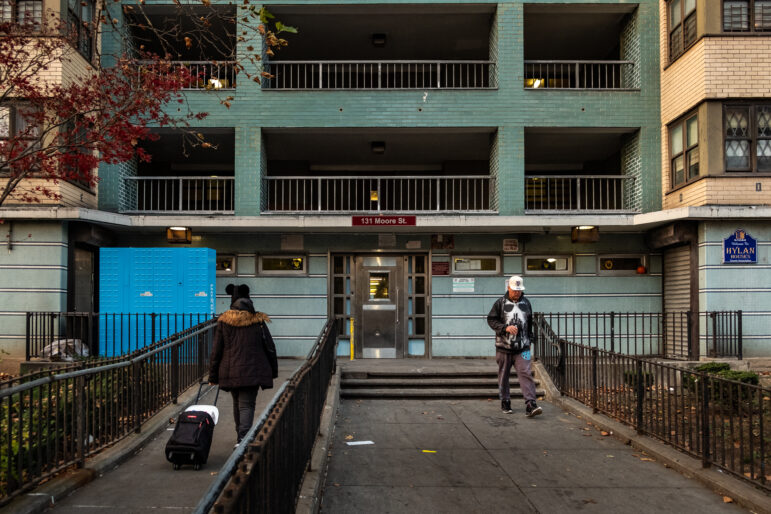At the Brooklyn complex, 83 tenants voted to join the Public Housing Preservation Trust and another 83 opted to convert to private management under the PACT initiative. A final recount will take place Jan. 8, and if the numbers stand, a runoff vote will be scheduled.

Adi Talwar
NYCHA’s Hylan Houses at 131 Moore St. in Brooklyn.After a 30-day election period, voters at NYCHA’s Hylan Houses are split over what funding model they want for their campus—and may be heading to a runoff vote to determine the path forward.
The 19-story development in Bushwick is the fifth NYCHA campus where tenants where asked to vote on whether they want to stay in the federal Section 9 public housing program, or join one of two other models for raising repair money: PACT or the Preservation Trust.
After three weeks of voting and 175 submitted ballots, a second tally held Friday found the results evenly split between PACT and the Trust, with 83 votes for each. A final recount will take place on Jan. 8, and should the tie still stand, residents will be asked to take part in a 30-day runoff vote, where just the Trust and PACT will be on the ballot, according to voting rules.
Both options would convert apartments at Hylan to Project-Based Section 8, another federal program that’s more lucrative than Section 9 and unlocks revenue streams that NYCHA can’t access on its own, like issuing bonds.
The Trust does this by leasing properties to the Trust itself, a public entity created in 2022 and overseen by a board of directors. Under the Permanent Affordability Commitment Together (PACT) program, NYCHA leases developments to private developers and management companies, which take over day to day operations and handle repairs. Since 2017, more than 37,000 NYCHA units have converted or are in the process of converting to PACT, though none have done so as a result of a tenant vote.
“With the current tie between PACT and the Trust, the key takeaway is that residents of Hylan Houses are overwhelmingly hoping for something new,” NYCHA Chief Executive Officer Lisa Bova-Hiatt said in a statement Friday. “It’s clear that residents want to see real changes to their homes, and we look forward to working closely with Hylan residents as we take the next step to see what the future holds.”
Home to 410 tenants in a single building at Moore and Humboldt streets, Hylan Houses is in need of approximately $90 million in maintenance and repairs over the next two decades, according to NYCHA. Tenants who previously spoke to City Limits cited concerns about lack of security in the building, plumbing issues and slow elevator service.

Adi Talwar
People in line to use a single elevator servicing over 200 apartments in NYCHA’s Hylan Houses, on Dec. 3, 2024.The building’s needs are part of a larger repairs backlog across NYCHA, which has an estimated $78.3 billion in renovation needs over the next 20 years, according to the housing authority. And Section 9, the traditional federal public housing program, has been underfunded by lawmakers in Washington for decades.
Should voting campuses opt to remain in Section 9, the “opportunity for development-wide repairs will be heavily constrained by funding,” NYCHA warned in a presentation shown to Hylan tenants. Still, some residents and leaders have criticized the move to private management, and have pushed to keep sites within Section 9. A recent comptroller audit found that PACT campuses had a higher eviction rate.
Should a runoff election be needed, only the two tied options, the Trust and PACT, would appear on the runoff ballot. Both earned 47.4 percent of the vote in the count that was re-tallied on Friday. Just over 5 percent of ballots, or nine of 175 votes, opted to stay with Section 9.
“From what I could tell, most tenants did not want that,” said Jared Soto, a member of the tenant association at Hylan Houses. “It’s essentially more of the same.”
If the tie is maintained by the final tally on Jan. 8, residents will get 30 days of notice before another 30-day runoff voting period. Soto said he was worried what impact a second election could have on voter turnout. At least 20 percent of “heads of households” at the campus must participate in an election for the results to count (in this most recent vote, 62 percent of “heads of households” took part, according to NYCHA).
“With the runoff, my biggest worry is that people will kind of just be turned off from the process. This has already been months going on,” Soto said. “I just hope that enough people are willing to come back, and maybe even more people are encouraged to come out to vote.”
To reach the editor, contact Jeanmarie@citylimits.org
Want to republish this story? Find City Limits’ reprint policy here.









